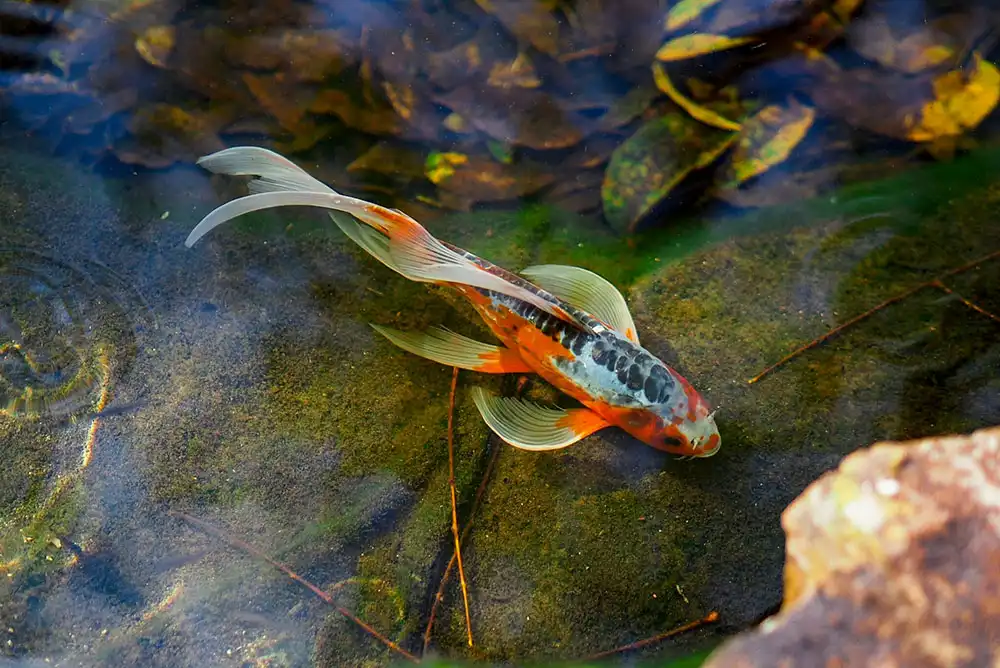
01 Jun How to Watch Out for KHV (Koi Herpes Virus)
Koi Herpes Virus (Cyprinid herpesvirus‑3) is a highly contagious pathogen that can wipe out 80–100 percent of a pond’s koi once it takes hold. Our mission at Aquatic Gardens is to ensure that never happens in Southern California ponds under our care.
How KHV Spreads in Southern California Ponds
- Fish‑to‑Fish Contact: Direct rubbing or spawning behavior is enough to pass viral particles.
- Shared Water or Aerosols: A show vat or dealer bag splash can transfer virus‑laden mucus.
- Contaminated Gear: Nets, pumps, and even damp hands move the virus between systems.
- Latent Carriers: Recovered koi may look healthy yet continue shedding virus whenever water reaches the “activation band” of 68–77 °F (20–25 °C).
Recognizing Early Symptoms
| Gill & Respiratory | External | Behavioral |
| Rapid breathing, gasping at the surface | Irregular white patches on gills or body | Lethargy, sunken eyes, loss of balance |
| Gill necrosis (burgundy‑brown gill tissue) | Excessive mucus, skin ulcers | Fish isolate near returns or in corners |
Incubation is temperature‑dependent—about three days at 75 °F (24 °C) but up to 30 days at 50 °F (10 °C).
Seasonal & Temperature Risk Windows
Southern California’s warm spring and fall water temperatures (68–77 °F) sit squarely in KHV’s sweet spot. Keep extra vigilance when daytime highs climb above 70 °F and nighttime lows remain over 60 °F for a week or more.
Biosecurity for New Arrivals
- Source Carefully – Buy only from dealers who certify KHV‑free stock.
- Dedicated Bags & Water – Insist on double‑bagged fish and discard transport water away from the pond.
- Equipment Segregation – Use color‑coded nets and tubs; disinfect between systems as described below.
Quarantine Protocol That Works
| Step | Detail |
| Duration | 4–6 weeks minimum at 68–75 °F (20–24 °C) to force viral expression. |
| System | Separate filter, heater, and test kit—no shared splashes. |
| Monitoring | Check fish twice daily; record appetite, respiration, and lesions. |
| Testing | PCR swab of gill filament or kidney if any sign emerges. |
Routine Health Monitoring & Testing
- Weekly: Observe behavior during feeding; note refusals or flashing.
- Monthly: Test ammonia, nitrite, KH, and keep a temperature log.
- Annually or Before Shows: PCR screening of a gill biopsy from a subset of fish; results typically within 72 hours.
Emergency Response Plan
- Isolate Affected Fish Immediately.
- Stop Transfers: Lockdown pumps or waterfalls that splash into secondary ponds.
- Notify Your Vet & Aquatic Gardens: Fast diagnosis shortens losses.
- Lower Water Temperature (<59 °F / 15 °C) to slow viral replication; combine with supplemental oxygen if feasible.
Prepare for Carcass Disposal: Double‑bag, freeze, and arrange municipal hazardous‑waste pickup to avoid wildlife contact.
Disinfection That Actually Kills the Virus
| Surface | Solution | Contact Time |
| Nets, tubs, hoses | 1 % Virkon S or 200 ppm bleach (½ cup household bleach per 10 gal) | 20 min soak → rinse, dry |
| Shoes & gloves | Spray 1 % Virkon S | Air‑dry completely |
| Tools (thermometers, probes) | 70 % isopropyl alcohol wipe | 2 min |
Always neutralize bleach with sodium thiosulfate before items re‑enter the pond.
Supportive Care & Treatment Possibilities
There is no antiviral cure. Supportive care focuses on:
- Extra aeration (≥ 8 mg/L dissolved oxygen).
- 1–0.3 % salt dips to ease osmoregulation stress.
- Broad‑spectrum antibiotics only for confirmed secondary bacterial infections (culture and sensitivity first).
Reporting Requirements in California
KHV is an OIE‑listed aquatic disease; confirmed cases must be reported to the State Veterinarian (CDFA Animal Health Branch) and to USDA APHIS Veterinary Services. Contact the Ontario District Office at (909) 947‑5932 or Headquarters at (916) 900‑5002 within 24 hours of laboratory confirmation.
Long‑Term Prevention & Pond Management
- Never Mix Species or Pop‑Ups: Keep goldfish, wild carp, and new koi in separate systems.
- Maintain Stable Water Quality: Ammonia 0, Nitrite 0, KH > 100 ppm—stress suppression is disease prevention.
- Annual Bio‑security Audit: Review quarantine logs, equipment labeling, and disinfection stations.
- Backup Power: Automatic generator or battery backup air pumps prevent temperature spikes during outages.
- Fish Health Records: Track individual purchases, illnesses, and lab results for every koi.
Final Thought
At Aquatic Gardens, we treat every koi as a living investment. By applying rigorous quarantine, diligent monitoring, and a rapid response plan, we keep KHV out of Southern California ponds and protect the beauty that drew you to koi in the first place.



